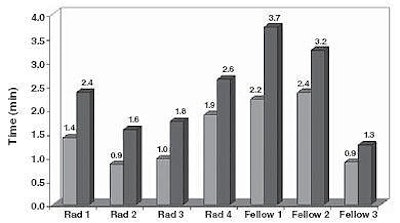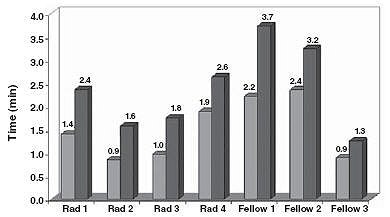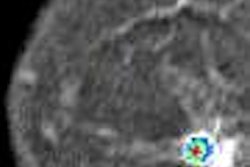
Since its launch on the U.S. market in 2000, digital mammography has enjoyed increasing confidence from the clinical community, due in part to research studies (including the Digital Mammographic Imaging Screening Trial) that have compared digital mammography's clinical efficacy to film-screen.
Yet not as much work has been done to investigate how digital mammography affects a facility's image acquisition and interpretation times as compared to analog. Researchers from Northwestern University in Chicago found that digital mammography's acquisition time proved more efficient than that of film-screen mammography (FSM), while its interpretation time was longer per exam than for analog studies. The study did not measure the accuracy of the interpretations of the two mammography screening techniques (American Journal of Roentgenology, July 2006, Vol. 187:1, pp. 38-41).
Digital exams were taken with a Senographe 2000D system (GE Healthcare, Chalfont St. Giles, U.K.), while FSM exams were taken on one of five FSM units, including three 800 T devices and one DMR unit (GE Healthcare), and one Mammomat 3000 device (Siemens Medical Solutions, Malvern, PA). All film-screen images were processed on one of two dedicated mammography daylight processors (Kodak Miniloader 2000P, Eastman Kodak, Rochester, NY) positioned within 50 feet of each mammography room.
Lead author Eric Berns, Ph.D., and colleagues measured acquisition times using nonoverlapping sets of 100 digital mammograms and 100 FSMs. Total acquisition time was defined as the time from when the technologist and woman first entered the mammography exam room to the release of the patient at the end of the procedure, including review of clinical history and image acquisition.
Acquisition times for film-screen mammography exams averaged 21.6 minutes, while acquisition time for digital studies averaged 35% less at 14.1 minutes. The main reason for the 7.5-minute acquisition time difference for digital exams was because film processing was unnecessary, according to the authors.
Technologists reviewed each digital image in the exam room itself on a 1-megapixel monitor, 10 seconds after exposure ended. In contrast, film-screen exams required the technologist to take the cassettes to the daylight processor, place them in the processor -- with a 20-second delay for each cassette -- wait 90 seconds for the film to process, label the films, put the films on a viewbox, and review each film's quality before returning to the exam room.
 |
| Average time for interpreting film-screen (light gray) and digital (dark gray) mammograms for each physician. Rad = radiologist. Berns EA, Hendrick RE, Solari M, Barke L, Reddy D, Wolfman J, Segal L, DeLeon P, Benjamin S, and Willis L, "Digital and Screen-Film Mammography: Comparison of Image Acquisition and Interpretation Times" (AJR 2006; 187:38-41). |
For the interpretation time comparison, the study included 183 hard-copy film-screen cases and 181 soft-copy digital cases (also nonoverlapping), and found that interpretation time averaged 1.4 minutes for film-screen mammography exams and 2.3 minutes for digital mammography exams, for a difference of 57%. Berns ascribed this difference to the manual image manipulation required to read digital images on a soft-copy review workstation -- this process isn't yet as efficient as reading images on a viewbox.
Earlier studies came to a different conclusion than the Northwestern data. Researchers from the University of North Carolina in Chapel Hill suggested that full-field digital mammography (FFDM) with soft-copy reading would not affect workflow negatively. Another study, conducted at the Ullevaal University Hospital in Oslo, Norway, stated that FFDM with soft-copy reading was comparable to FSM (Radiology, May 2002, Vol. 223:2, pp. 483-488; December 2003, Vol. 229:3, pp. 877-884).
Workflow may prove to be the make-or-break factor in digital mammography's assimilation into the clinical mainstream, according the current study's authors. With low reimbursement levels for breast screening, breast imaging centers look to heavy patient throughput for financial viability. FFDM has been shown to add clinical benefit, particularly for high-volume centers, but without workflow advantages, the adoption of the technology may decrease.
To address the interpretation time discrepancy, Berns and colleagues recommended that review workstation manufacturers improve functionality so that soft-copy interpretation of digital mammograms becomes more efficient. They also suggested that radiologists adjust their time allocation for interpreting digital studies.
By Kate Madden Yee
AuntMinnie.com contributing writer
August 10, 2006
Related Reading
New workflow, personnel needed for adopting digital mammography, August 10, 2006
Take care when coding for digital mammography and CAD, July 13, 2006
Digital mammography: Can your facility afford to make the leap? May 11, 2006
FFDM may make mobile breast cancer screening programs more viable, November 29, 2005
Do DMIST results underestimate FFDM's impact? October 24, 2005
Copyright © 2006 AuntMinnie.com




















